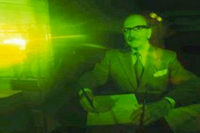








Holography is a technique which enables three-dimensional images (holograms) to be made. It involves the use of a laser, interference, diffraction, light intensity recording and suitable illumination of the recording. The image changes as the position and orientation of the viewing system changes in exactly the same way as if the object were still present, thus making the image appear three-dimensional.
Holography dates from 1947, when British (native of Hungary) scientist Dennis Gabor developed the theory of holography while working to improve the resolution of an electron microscope.Gabor coined the term hologram from the Greek words holos, meaning "whole," and gramma, meaning "message". Further development in the field was stymied during the next decade because light sources available at the time were not truly "coherent" (monochromatic or one-color, from a single point, and of a single wavelength).
The development of the laser enabled the first practical optical holograms that recorded 3D objects to be made in 1962 by Yuri Denisyuk in the Soviet Union and by Emmett Leith and Juris Upatnieks at the University of Michigan, USA.Early holograms used silver halide photographic emulsions as the recording medium. They were not very efficient as the produced grating absorbed much of the incident light. Various methods of converting the variation in transmission to a variation in refractive index (known as "bleaching") were developed which enabled much more efficient holograms to be produced.
Several types of holograms can be made. Transmission holograms, such as those produced by Leith and Upatnieks, are viewed by shining laser light through them and looking at the reconstructed image from the side of the hologram opposite the source.A later refinement, the "rainbow transmission" hologram, allows more convenient illumination by white light rather than by lasers.Rainbow holograms are commonly used for security and authentication, for example, on credit cards and product packaging.
Another kind of common hologram, the reflection or Denisyuk hologram, can also be viewed using a white-light illumination source on the same side of the hologram as the viewer and is the type of hologram normally seen in holographic displays. They are also capable of multicolour-image reproduction.
Specular holography is a related technique for making three-dimensional images by controlling the motion of specularities on a two-dimensional surface.It works by reflectively or refractively manipulating bundles of light rays, whereas Gabor-style holography works by diffractively reconstructing wavefronts.
Most holograms produced are of static objects but systems for displaying changing scenes on a holographic volumetric display are now being developed.
Holograms can also be used to store, retrieve, and process information optically.
In its early days, holography required high-power expensive lasers, but nowadays, mass-produced low-cost semi-conductor or diode lasers, such as those found in millions of DVD recorders and used in other common applications, can be used to make holograms and have made holography much more accessible to low-budget researchers, artists and dedicated hobbyists.
It was thought that it would be possible to use X-rays to make holograms of very small objects and view them using visible light.Today, holograms with x-rays are generated by using synchrotrons or x-ray free-electron lasers as radiation sources and pixelated detectors such as CCDs as recording medium.The reconstruction is then retrieved via computation. Due to the shorter wavelength of x-rays compared to visible light, this approach allows to image objects with higher spatial resolution.As free-electron lasers can provide ultrashort and x-ray pulses in the range of femtoseconds which are intense and coherent, x-ray holography has been used to capture ultrafast dynamic processes.